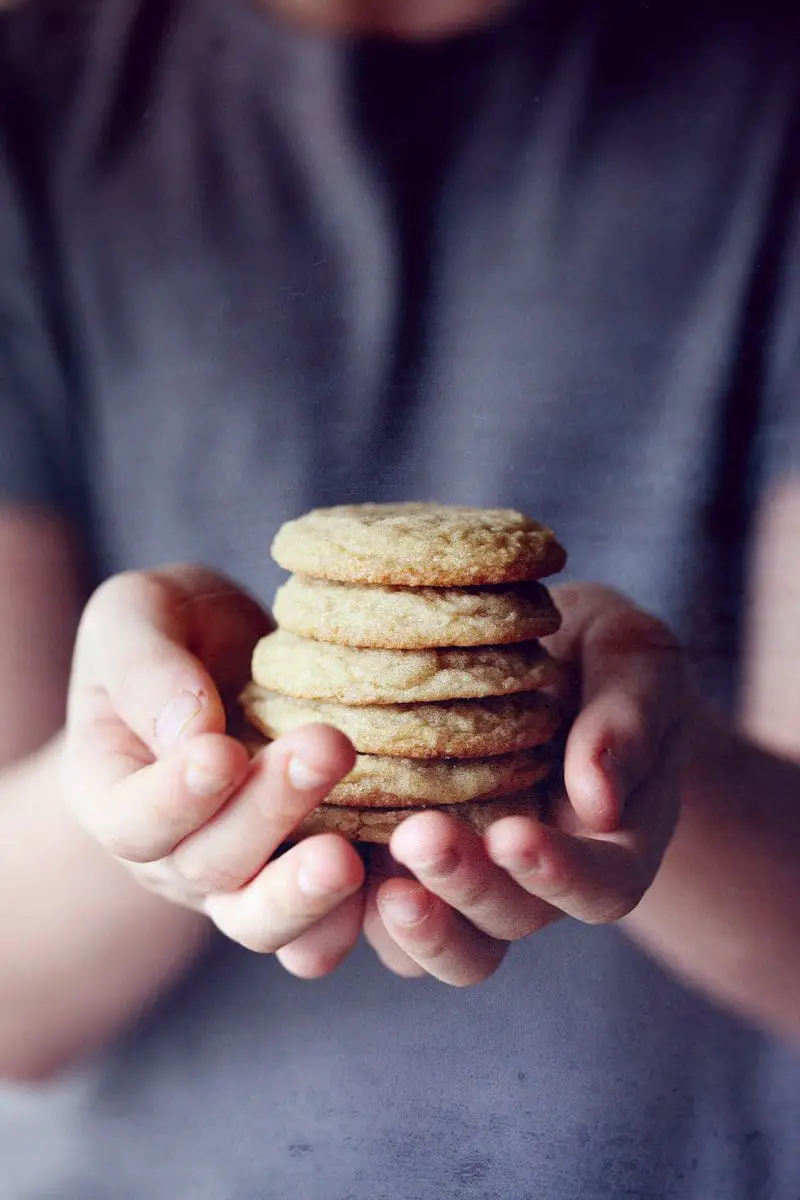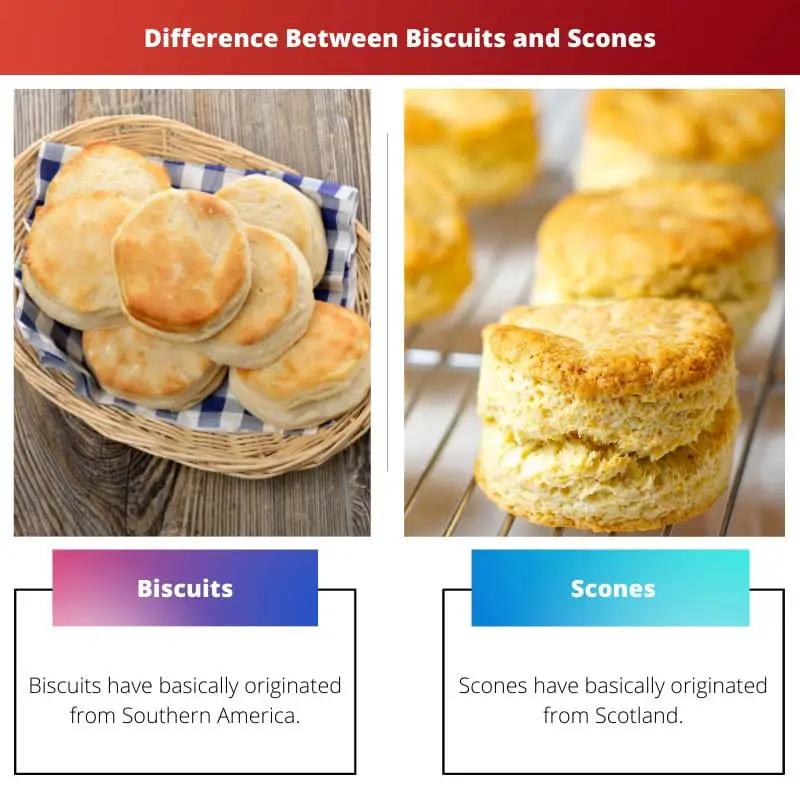Every person wants to eat and serve the best possible cookies. Two such types of cookies, biscuits and scones, differ in very minute aspects, but understanding these differences is essential for making the right kind of purchase decisions when it comes to cookies.
Key Takeaways
- Biscuits have a flaky texture and are savory, while scones are denser and sweetened.
- Scones contain additional ingredients like fruit or nuts, while biscuits are more likely to be plain or served with gravy.
- The biscuit dough has a higher fat-to-flour ratio, resulting in a lighter, flakier texture than scones.
Biscuits vs Scones
Biscuits are light and fluffy with flaky layers, while Scones are crisp outside with a tender interior. Biscuits have little or no sugar, and the dough is kneaded, while in a Scone, sugar is added, and the dough is not kneaded. Biscuits don’t contain eggs, while scones do contain eggs.

Biscuits are flour-based cookies that originated in Southern America. They are basically made of ingredients like chocolate, sugar, and cinnamon.
Biscuits are available in various categories like digestive biscuits, Nutri Choice biscuits, flavoured biscuits, and cream biscuits. In some areas of the United States, people serve biscuits along with gravy as well.
Scones have basically originated in Scotland, where people absolutely love eating scones. Historically, scones were round and flat. They were served along with tea or coffee at breakfast or evening time.
They may be sweet as well as savoury. There are various types of scones, like potato scones, drop scones and lemonade scones.
Comparison Table
| Parameters of Comparison | Biscuits | Scones |
|---|---|---|
| Source of Origin | Biscuits have basically originated from Southern America. | Scones have basically originated from Scotland. |
| Sugar content | Biscuits have no or very little sugar added to them. | Scones have more sugar added to them when compared to biscuits. |
| Shape and type of dough | Generally, biscuits are round in shape. The dough here is highly kneaded. | Generally, some scones are round or triangular. The dough here is not much kneaded. |
| Flavor level | Biscuits do not carry any sort of flavor, they are plain, but sometimes a certain amount of cheese or herbs may be added. | Scones carry a different variety of flavors which may include fruits and nuts. |
| Complimentary | Biscuits are served and enjoyed along with a meal, a lunch, or a dinner. | Scones are commonly served and enjoyed along with afternoon or cream tea. |
| Taste and appearance | Biscuits are basically light in weight and have fluffy and flaky layers. | Scones are crispier on the outside but are tender in the interior. |
What are Biscuits?
Biscuits are one of the highly demanded items all over the world that are highly enjoyed by all consumers. Biscuits have a cereal base and component of at least 60-70%.
The flaky nature of biscuits differentiates them from the rest of the cookies in the market. Biscuits are made from a dough that is majorly consistent with the dough of bread.
Generally, biscuits are served along with gravy in Southern America.
One type of biscuit called glucose biscuits is very popular in countries like India and Malaysia, where most people consume these biscuits along with tea. Parle G, a glucose biscuit brand in India, sells almost 130 billion packets in a month.
Initially, biscuits were hardened, dry, and highly unsweetened. Biscuits are served with meals in the United States of America. Sugars have basically no or very little sugar added to them.
There are various types of biscuits with different brands and different shapes that are available in the market.
In India, biscuits are loved in every household. People here serve biscuits to the guests with tea, whereas in the US, people serve biscuits along with gravy. The popular brands of biscuits in India are Britannia, Parle-G, and Nestle.

What are Scones?
Scones originated in Scotland in the early 1500s. Initially, scones were served along with clotted cream and preserves.
Scones are heavier when compared to biscuits, due to which more ingredients are utilized in the process of making scones. They have a good amount of sugar content which is far more than that of biscuits.
Scones are highly crispy and crunchy outside, with tenderness in the interior. They are served all around the world along with afternoon tea or cream tea.
Historically, scones were of the same size as a medium-sized plate, but gradually, with time, their size decreased, and now they are the same size as biscuits.
When scones are made, the dough is not kneaded, which makes it an extremely tough thud spoiling its classic texture. Then the scone is rolled into a ball. Then the dough is patted and cut with a cutter to make even pieces of scones.
The world-famous brands of scones are Marks & Spencer, Becky’s Bakery scones, and Wholefood Market plain scones. Scones are highly consumed in countries like America, Scotland, England, and South Africa. Here people love eating scones with afternoon tea or cream tea.

Main Differences Between Biscuits and Scones
- Biscuits have originated from the United States of America, whereas scones have originated from Scotland.
- Biscuits have no or very little sugar added to them. On the other hand, scones have a good amount of sugar added to them.
- Biscuits are enjoyed along with a meal, lunch, or dinner, while scones are enjoyed with a cup of afternoon tea or morning tea.
- Biscuits are most of the time round in shape, whereas scones are sometimes round in shape and other times triangular in shape.
- The major brands of biscuits are Britannia, Nestle, and Parle-G. On the other hand, the prominent brands of scones are Marks & Spencers, Becky’s Bakery Scones, and Wholefood Market plain scones.

- https://academic.oup.com/heapro/article-abstract/32/1/113/2950945
- https://www.cabdirect.org/cabdirect/abstract/20000404909





The section on ‘What are Biscuits?’ provided me with extremely useful information. I’ve actually never eaten a biscuit with gravy.
Really? You should definitely give it a try.
You’ll love it.
The information about the origin and ingredients of biscuits and scones is really helpful. I’m glad the post mentions how the differences in texture, sweetness levels, and flavor of each separate them
This was a very well researched post. I appreciate that the author took the time to delve into the historical aspects of scones.
I agree, the post is very informative. My favorite part was learning about the history of scones.
The comparison table and the information about the origin of each really clarified the differences between biscuits and scones. Great work.
Yes, it helped me understand the differences better, too.
I would have liked the article to also explore the nutritional aspects of biscuits and scones. Still, a great post overall.
I prefer scones, they are more versatile than biscuits. I can have them in the morning with coffee or in the afternoon with tea.
Yes, scones are a more flexible baked good.
I’m more of a biscuit person, but this post definitely made me reconsider that. I might have to try scones soon.
You should try it with clotted cream. You’ll love it.
Scones are a great choice.
The variety of flavors of scones sounds interesting, especially when compared to the plain flavor of biscuits.
I’ve tried a few of those flavors. Lemonade scones are my favorite.
This was a very interesting post. I didn’t know that the dough for scones isn’t kneaded. It’s amazing how one small difference can make such a change.
It’s a game-changer.
Who knew?
It’s amazing how many differences there are between biscuits and scones. The post does a good job highlighting the fine details of both.
I agree. Now I know how to tell them apart. And as far as a preference, I would go with scones.